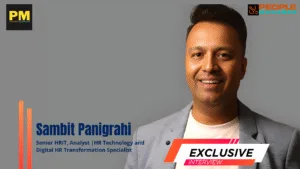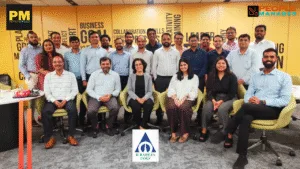Sakshi Pal on How the latest HR Trends shaping the future of HR Strategies
The future of hiring isn’t about where you studied—it’s about what you can do and how fast you can learn. When you hire for skills, you invest in potential—not just past experience.- Sakshi Pal

In today’s rapidly evolving tech industry, building an inclusive, collaborative, and empowering workplace culture is more critical than ever. The People Manager’s conversation with Sakshi Pal, India Head- HR Techwave, sheds light on how innovative strategies like skills-based hiring and the integration of AI are revolutionizing recruitment and HR practices. By shifting the focus from traditional degrees to actual competencies, Techwave has successfully expanded its talent pool and aligned its recruitment efforts more closely with client and project needs. This transformation has not only reduced the time-to-hire but also enhanced the quality of candidates, ensuring a workforce that is adaptable to the ever-changing tech landscape.
The interview also delves into the significant role of AI in enhancing HR practices and decision-making processes. Techwave’s adoption of AI-driven tools has streamlined talent acquisition, optimized sourcing strategies, and enabled real-time performance management. These advancements, coupled with comprehensive upskilling and reskilling programs, have fostered a culture of continuous learning and innovation. Additionally, the discussion explores the impact of employee wellness programs on productivity and job satisfaction, the transformative power of people analytics in shaping HR strategies, and the future trends that organizations must prepare for to stay ahead in the competitive tech industry. Through these insights, Techwave demonstrates its commitment to creating a workplace that values diversity, promotes collaboration, and empowers its diverse talent.
WATCH THE VIDEO INTERVIEW @ PMHRTV- PEOPLE MANAGER HR MAGAZINE
PM: How is skills-based hiring transforming recruitment strategies in tech industries?
SP: Skills-based hiring is revolutionizing tech recruitment by shifting the focus from traditional degrees to practical expertise. At Techwave, this approach has expanded our talent pool, allowing us to identify candidates with hands-on experience in high-demand technologies like AI/ML, cloud computing, and Golang. By prioritizing competencies over credentials, we’ve streamlined hiring, reducing time-to-fill positions by 30% and ensuring a stronger match between talent and project needs.
This strategy also enhances workforce agility—helping employees reskill and transition into emerging roles. Through SPARK, our EVP, we invest in continuous learning, ensuring our team stays ahead of industry trends. Skills-based hiring not only attracts top talent but also fosters a dynamic, future-ready workforce that can quickly adapt to evolving technological landscapes.
PM: Can you explain the role of AI in enhancing HR practices and decision-making processes?
SP: At Techwave, AI enhances engagement and accuracy while driving efficiency in HR practices. We deploy AI-powered tools to facilitate talent acquisition through predictive analytics and optimize sourcing strategies for top candidates. AI enables real-time feedback and personalized development plans during performance management, guaranteeing uninterrupted support for employees’ career development.
Additionally, AI can improve workforce planning by forecasting suitable recruitment efforts to fill potential skill gaps. Furthermore, it enhances the employee experience; for example, at Techwave, we implemented AI chatbots to handle HR inquiries, which has decreased resolution time by 50%, letting our head office concentrate on more strategic initiatives. Incorporating AI into our organizational HR practices allows us to build a data-centric and employee-centered workplace.
PM: What are the key benefits of upskilling and reskilling programs for both employees and employers?
SP: Upskilling and reskilling programs offer immense benefits for both employees and employer’s professional advancement, business innovation, and long-term success. SPARK which is a part of our Employee Value Proposition program at Techwave SPARK helps employees in achieving their personal and professional goals. Under SPARK, ‘A’ stands for Aid Professional and Personal goals, reinforcing our commitment to fostering a culture of continuous learning. It is important for ensuring the competitiveness of the company within the industry while enabling the employees to continuously develop skills that are relevant in the evolving tech industry.
An employee benefits through these programs via job security, career advancement and overall adaptability. Having more knowledge enables employees to gain confidence, engage more in their jobs and increases the overall satisfaction of doing their work which empowers them to take on new challenges and leadership positions. As for Techwave, investing in learning and development serves to close skill gaps, boost innovation and enhance project delivery. Lowering dependence and reliance on outside hiring, facilitates movement amongst staff members internally while also forming a skilled employee base that can tackle challenges in the years to come. One example is the Internal AI & Cloud certification program that within one year, allowed for an estimated 60% of trained employees to take on newly created AI roles that reduced hiring non-trained staff by up to 35%.
PM: How do employee wellness programs contribute to overall productivity and job satisfaction?
SP: At Techwave, employee wellness programs play a crucial role in fostering a healthy, engaged, and productive workforce. Under our SPARK program, where ‘P’ stands for Provide Holistic care, we focus on physical and mental well-being, work-life balance, and flexible work arrangements. Our initiatives, including yoga, dance therapy, ergonomics, and mindfulness sessions, are designed to cater to the diverse needs of our multi-generational workforce.
The transition to hybrid work models has further contributed to reduced absenteeism, higher morale, and increased productivity. A strong wellness culture directly impacts job satisfaction and retention, helping to lower turnover rates. To measure effectiveness, we actively gather employee feedback and make necessary improvements. Our Employee Net Promoter Score (eNPS) stands at 8%, reflecting the impact of our wellness efforts on workplace satisfaction.
PM: In what ways is people analytics shaping the future of HR strategies?
SP: People analytics is transforming HR strategies at Techwave by enabling data-driven decision-making. By analyzing patterns in employee performance, retention, and engagement, we design more effective HR initiatives. In performance management, HR leverages analytics to track skill gaps, assess promotion readiness, and develop personalized growth plans for employees. When it comes to retention and engagement, AI-driven sentiment analysis helps predict attrition risks by evaluating employee feedback surveys, allowing us to implement proactive retention strategies. Workforce planning is another key area where predictive analytics enables HR to forecast hiring needs and plan leadership succession.
For instance, tracking recruitment costs and key workforce metrics has significantly improved our hiring efficiency as part of the TAG roadmap. One major success at Techwave has been our attrition prediction model, which helped us retain 30% of at-risk employees by offering them targeted development programs. By integrating people analytics into our HR strategies, we create a more agile, data-driven, and employee-centric workplace.
PM: What challenges do organizations face when implementing AI in HR, and how can they be overcome?
SP: Implementing AI in Human Resources has its unique challenges which may include data protection, employee bias, and integration within existing systems. Companies can use AI while remaining compliant and fair, but it requires a more proactive approach to problem-solving. Similar issues were faced by us at Techwave, and we were able to overcome them by being transparent with the performance of our AI systems, training HR personnel to detect and deal with biases, and helping change the culture into a more technological driven one. For instance, when we implemented AI for recruitment, we made AI-assisted HR managers crosscheck the AI assessments in order to reduce bias, so we were able to balance equity and diversity in our selection. By blending AI and human intervention, we have increased the number of effective decisions made in the company while ensuring that the decisions are just and impartial.
PM: How can companies ensure their upskilling and reskilling initiatives are effective and aligned with industry needs?
SP: To ensure upskilling and reskilling initiatives are effective and aligned with industry needs, companies must take a strategic, data-driven approach. Regular skills gap analyses, client feedback, and industry trend monitoring help identify the most relevant competencies employees need. At Techwave, we continuously refine our training programs, such as Golang training, Hybris training, Tech boot camps, webinars, and enablement initiatives, to meet evolving project demands.
Leveraging AI-driven learning platforms and personalized development plans enhances engagement and effectiveness. We also incorporate feedback loops and performance assessments to ensure these initiatives remain aligned with business objectives. One example is Techwave’s AI Academy, co-created with industry leaders, which has trained over 250 employees, increasing internal mobility by 40%.
By integrating targeted learning opportunities with real-time industry insights, we create a future-ready workforce equipped to drive innovation and business growth.
PM: What metrics should companies track to measure the success of their employee wellness programs?
SP: At Techwave, we track key metrics such as employee engagement scores, absenteeism rates, productivity, and turnover to measure the impact of our wellness program, SPARK—our Employee Value Proposition (EVP).
High engagement scores and productivity levels indicate a positive workplace environment, while lower absenteeism and turnover suggest improved employee well-being and job satisfaction. We also monitor participation rates in wellness initiatives and gather real-time feedback through pulse surveys to assess program effectiveness. These insights help us identify trends, address emerging concerns, and continuously enhance our wellness offerings to better support our employees.
PM: How can HR professionals leverage people analytics to predict and address workforce trends?
SP: The use of people analytics by an organisation’s human resource department can improve decision-making and workforce planning. Retention and productivity trends can be established by looking at the metrics of performance, engagement, attrition, and skill gaps. The use of predictive analytics for anticipating turnover risks allows proactive measures such as retention and career development initiatives to be implemented. AI-driven sentiment analysis provides real-time data that improves hiring strategies and helps foster a more positive work environment. Overall, the use of people analytics brings agility and employee centricity to the workplace which guarantees success in the long term.
Much like with our Advanced Analytics, we use people analytics at Techwave to help forecast and prepare for changes in the workforce. We capitalize on performance reviews, engagement survey results, and hiring pattern data to fill talent gaps effectively. To supplement the talent gaps, we enhance workforce planning through predictive analytics on the headcount, mobility trends, and talent strategies. By reviewing hiring and promotion data, we are able to reduce bias amongst employees and set a standard for equal opportunity and improve diversity within the company. Ultimately, we can build a more inclusive and agile workforce that is ready to face the future.
PM: What future trends do you foresee in HR practices, and how can companies prepare for them?
SP: We anticipate greater integration of AI in HR processes, an increased emphasis on diversity, equity, and inclusion (DEI), and the continued evolution of remote and hybrid work models. At Techwave, we are preparing for these trends by investing in technology, promoting continuous learning, and developing flexible workplace policies to support a diverse, global workforce.For further insights into the evolving workplace paradigm, visit
- How this Healthcare Company Prioritizes Career Growth, Internal Mobility, and Continuous Learning to Retain Talent - July 24, 2025
- Why Are Dell Employees Reeling Under Work Pressure? - July 23, 2025
- How an software engineer become HCM architect to align enterprise solutions in Human-Centered HR Digitization - July 19, 2025








